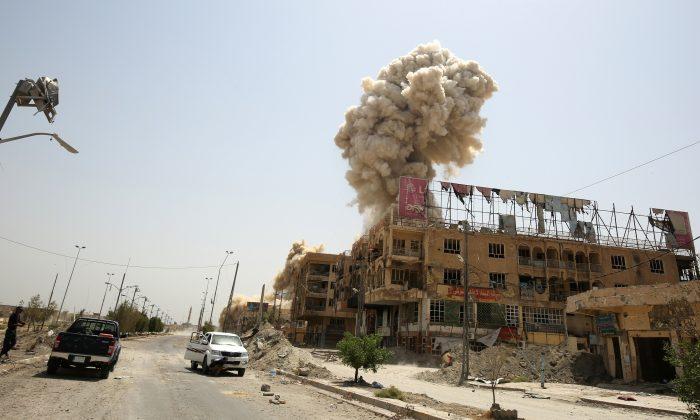NITZAN, Israel—Residents of a small, depressed community called Nitzan in southern Israel may not appear remarkable, but their story as evacuees from the Gaza Strip and subsequent turbulent relocation and recovery is.
Five years ago on Aug. 17, they were among more than 9,000 Israelis who were removed from the Gaza Strip and Northern Samaria by the Israeli military.
Then-Prime Minister Ariel Sharon campaigned vigorously for the pullout.
“Disengagement has two main purposes: enhancing Israel’s security by reducing terrorism, and boosting Israel’s economy by improving the quality of life,” said Sharon in a December 2003 speech.
Although warned in advance by the government that Israel would unilaterally withdraw its citizens from an area in Gaza called Gush Katif, many people hoped for a miracle up until the last minute.
“We were so naïve,” said Debi Rozen, a tour guide at the Gush Katif Museum in Jerusalem and former media spokesperson for Gush Katif.
“We didn’t prepare because we didn’t want to prepare,” she said while walking among memorabilia in the museum of grass-roots protest efforts in 2005 to stop the evacuation. Rozen, recalling the day the evacuation started said, “You couldn’t imagine so many soldiers.”
The Rozen family was among many Gush Katif residents who refused to leave their homes and communities voluntarily. Thousands of Israeli soldiers and police were forced to literally carry people out of their homes and synagogues.
Five years ago on Aug. 17, they were among more than 9,000 Israelis who were removed from the Gaza Strip and Northern Samaria by the Israeli military.
Then-Prime Minister Ariel Sharon campaigned vigorously for the pullout.
“Disengagement has two main purposes: enhancing Israel’s security by reducing terrorism, and boosting Israel’s economy by improving the quality of life,” said Sharon in a December 2003 speech.
Although warned in advance by the government that Israel would unilaterally withdraw its citizens from an area in Gaza called Gush Katif, many people hoped for a miracle up until the last minute.
“We were so naïve,” said Debi Rozen, a tour guide at the Gush Katif Museum in Jerusalem and former media spokesperson for Gush Katif.
“We didn’t prepare because we didn’t want to prepare,” she said while walking among memorabilia in the museum of grass-roots protest efforts in 2005 to stop the evacuation. Rozen, recalling the day the evacuation started said, “You couldn’t imagine so many soldiers.”
The Rozen family was among many Gush Katif residents who refused to leave their homes and communities voluntarily. Thousands of Israeli soldiers and police were forced to literally carry people out of their homes and synagogues.
According to the Israeli Ministry of Foreign Affairs, four groups of towns and villages in Gaza were evacuated. Among them were the towns and villages of Gush Katif.
Families that had been recruited by the government three decades earlier to settle and farm the desert of Gush Katif found themselves starting over. Some were already nearing retirement age. Despite some compensation and assistance from the government, some evacuees have faced one difficulty after another in restoring their stability and quality of life.
In Nitzan, where 500 families settled, only 40 families have moved from transitional housing to permanent housing, according to Lior Kalafa, general secretary of Nitzan.
Kalafa, who is a former mayor of a community in Gush Katif, says that one of the greatest challenges residents of Nitzan face is finding work. He says unemployment is as high as 70 percent.
More than that, though, Kalafa doesn’t think the disengagement did anything to solve Israel’s security situation.
Families that had been recruited by the government three decades earlier to settle and farm the desert of Gush Katif found themselves starting over. Some were already nearing retirement age. Despite some compensation and assistance from the government, some evacuees have faced one difficulty after another in restoring their stability and quality of life.
In Nitzan, where 500 families settled, only 40 families have moved from transitional housing to permanent housing, according to Lior Kalafa, general secretary of Nitzan.
Kalafa, who is a former mayor of a community in Gush Katif, says that one of the greatest challenges residents of Nitzan face is finding work. He says unemployment is as high as 70 percent.
More than that, though, Kalafa doesn’t think the disengagement did anything to solve Israel’s security situation.
“Israel is now dealing with diplomatic and security problems that exceed what they had prior to the disengagement,” quipped Kalafa while standing inside a partly finished building in Nitzan that will eventually serve as a community center.
A physical example of the security risks Nitzan residents live with are the numerous makeshift concrete bomb shelters scattered throughout the town.
But the small, hopeful signs of recovery and life in Nitzan like the community center seem almost heartbreaking at the same time. “Caravillas”—or temporary housing provided by the government for evacuees—line the nearly silent suburban streets. Two or three children play listlessly on their bikes in the blazing hot sun. A candy store with no customers sits on a corner facing a modest pizzeria—the only two retail businesses opened by residents here.
Some of the hesitancy to start over, even after five years, could be related to the average age of Nitzan residents, which is about 50 years old according to town administration. Laurence Beziz, a spokeswoman for the Friends of Gush Katif Projects and a resident, believes that has impacted the recovery of many people in Nitzan who were younger and more able-bodied when they started their lives in Gush Katif.
A physical example of the security risks Nitzan residents live with are the numerous makeshift concrete bomb shelters scattered throughout the town.
Signs of Recovery
But the small, hopeful signs of recovery and life in Nitzan like the community center seem almost heartbreaking at the same time. “Caravillas”—or temporary housing provided by the government for evacuees—line the nearly silent suburban streets. Two or three children play listlessly on their bikes in the blazing hot sun. A candy store with no customers sits on a corner facing a modest pizzeria—the only two retail businesses opened by residents here.
Some of the hesitancy to start over, even after five years, could be related to the average age of Nitzan residents, which is about 50 years old according to town administration. Laurence Beziz, a spokeswoman for the Friends of Gush Katif Projects and a resident, believes that has impacted the recovery of many people in Nitzan who were younger and more able-bodied when they started their lives in Gush Katif.
“At 45 or 50 years old, it’s a little hard to start from scratch,” said Beziz in Nitzan on Monday, adding that there are certain social difficulties that come with starting over. “All this uncertainty put a lot of pressure [on families].”
Not every story of Gush Katif evacuees has trailed off into disappointment and uncertainty, though. Just down the road, signs of life and renewal are literally growing everywhere at the Sender Nursery. Husband and wife team Moti and Chana Sender work among the ornamental plants they grow for export, determined to survive.
Like many former Gush Katif residents, they were farmers and what Israelis fondly refer to as “salt of the earth.”
Their business, which will transfer to its permanent location next month, is in Yad Mordechai and only 10 minutes from the somber community of Nitzan. But it might as well be a different world.
As Moti, who is a grandfather, sits in the lush grass in front of his nursery, he muses about why he chose to start over again more than 30 years after starting from scratch in Gush Katif.
“I thought I would never go back to agriculture,” said Moti, who was unemployed for a full year before re-establishing his nursery. “But,” he added simply, “I wanted my grandchildren to believe it could be done.”
Not every story of Gush Katif evacuees has trailed off into disappointment and uncertainty, though. Just down the road, signs of life and renewal are literally growing everywhere at the Sender Nursery. Husband and wife team Moti and Chana Sender work among the ornamental plants they grow for export, determined to survive.
Like many former Gush Katif residents, they were farmers and what Israelis fondly refer to as “salt of the earth.”
Their business, which will transfer to its permanent location next month, is in Yad Mordechai and only 10 minutes from the somber community of Nitzan. But it might as well be a different world.
As Moti, who is a grandfather, sits in the lush grass in front of his nursery, he muses about why he chose to start over again more than 30 years after starting from scratch in Gush Katif.
“I thought I would never go back to agriculture,” said Moti, who was unemployed for a full year before re-establishing his nursery. “But,” he added simply, “I wanted my grandchildren to believe it could be done.”



